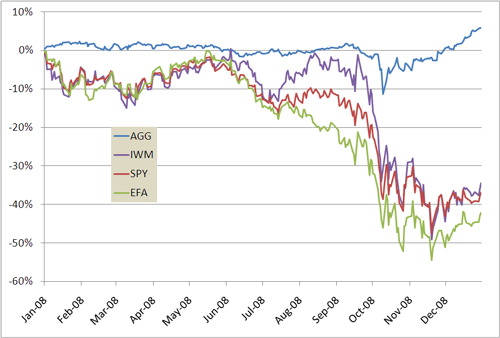It s Hard To Top Traditional Diversification
Post on: 30 Апрель, 2015 No Comment

Investors have been looking far and wide to achieve what they believe is meaningful portfolio diversification—using commodities, long/short strategies, multi-sector funds and various other “alternatives.” While the actual return numbers are beyond the scope of this note, let’s just say they’ve been disappointing. Especially when you consider the most effective and reliable portfolio diversification is also the simplest and most traditional.
Let’s look at the last twenty years of results for global stock and bond asset classes* and balanced portfolios. Twenty years is long enough to start drawing reasonable conclusions and corresponds with the majority of time investors spend saving for retirement or in retirement.
The table above shows that the US large and small value stock asset classes produced meaningfully higher returns than the S&P 500 over the last two decades, but as expected, with generally higher stand-alone risk. The same holds for international large and small value stock asset classes relative to the international index, despite the fact that foreign stocks across the board trailed our domestic market.
The story changes when we look at portfolio results. The “All-Stock Asset Class Mix,” a 70% US and 30% non-US stock allocation (tilted to value and small cap stocks domestically and exclusively in value and small cap stocks abroad) had:
- higher returns AND less risk than either the S&P 500 or international indexes by themselves, despite trailing US large and small value returns, the globally diversified all-stock asset class portfolio had lower risk than any of the individual stock asset classes. and outperformed the “Stock Index Mix” (70% S&P 500, 30% EAFE) by about 2% per year without taking any additional risk (standard deviation of 19.0 vs. 18.9).
Higher risk-adjusted returns for the diversified stock portfolio meant that adding 35% in short-term bonds (the “Balanced Asset Class Mix”) still produced a return of within 0.5% of the S&P 500, almost 4% per year more than the international index, and 0.6% better than the Stock Index Mix, all while exhibiting a level of risk that was 35% to 40% less than the individual stock indexes.
Regardless of what you’ve been told by Wall Street marketing departments, there is no need to chase alternative asset classes with relatively high fees, opaque strategies and extreme tax inefficiency. Meaningful portfolio diversification can be achieved simply by including large and small value stocks globally along with high quality, short-term bonds where necessary. These approaches have resulted in lower overall portfolio risk with returns that exceed general stock indexes or that match their returns with considerably lower volatility. Nothing works all the time, but recent history shows it would be foolish to forgo the benefits of traditional asset class diversification.
_______________________________________
Source of data. DFA Returns 2.0
*Asset classes include only those available to invest in 20 years ago which exclude emerging markets, whose small cap and value series began trading in 1998.
S&P 500 Index = DFA US Large Company fund (DFUSX, DFLCX prior to 2010)
US Large Value stocks = DFA US Large Value fund (DFLVX)
US Small Value stocks = DFA US Small Value fund (DFSVX)
Int’l EAFE Index = DFA Large Company Int’l fund (DFALX)
Int’l Large Value stocks = DFA Int’l Value fund (DFIVX)
Int’l Small Value stocks = DFA Int’l Small Value fund (DISVX)
Short-Term bonds = DFA Five-Year Global Bond fund (DFGBX)
All-Stock Asset Class Mix = 21% S&P 500, 21% US Large Value stocks, 28% US Small Value stocks, 18% Int’l Value stocks, 12% Int’l Small Value stocks (rebalanced annually)
Balanced Asset Class Mix = 13.5% S&P 500, 13.5% US Large Value stocks, 18% US Small Value stocks, 12% Int’l Value stocks, 8% Int’l Small Value stocks, 35% Short-Term bonds (rebalanced annually)
Stock Index Mix = 70% S&P 500, 30% Int’l EAFE Index (rebalanced annually)
Past performance is not a guarantee of future results. There are limitations inherent in model performance; it does not reflect trading in actual accounts and may not reflect the impact that economic and market factors may have had on an advisor’s decision-making if the advisor were managing actual client money. Model performance is hypothetical and is for illustrative purposes only. Model performance shown includes reinvestment of dividends and other earnings but does not reflect the deduction of investment advisory fees or other expenses except where noted. This content is provided for informational purposes and is not to be construed as an offer, solicitation, recommendation or endorsement of any particular security, products, or services.














